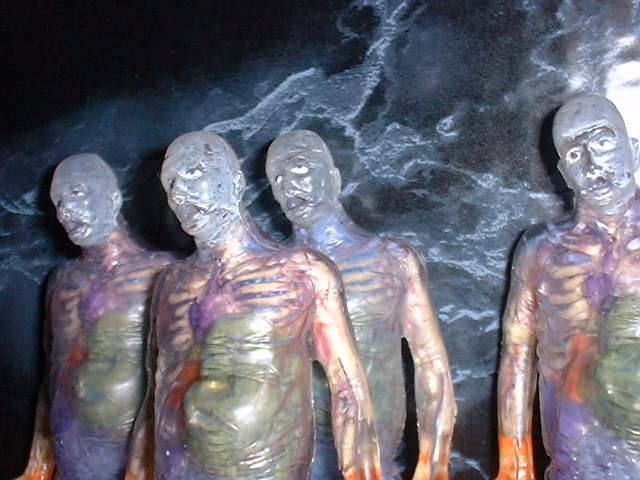 A doppelganger is the ghostly or in some cases, a physical double of a living person. The word doppelganger is a loanword from German, written there (as any noun) with an initial capital letter Doppelgänger, composed from doppel, meaning "double", and gänger, as "walker". In English, the word is conventionally not capitalized, and it is also common to drop the German diacritic umlaut on the letter "a" and write "doppelganger", although the correct spelling without umlaut would be "doppelgaenger".
A doppelganger is the ghostly or in some cases, a physical double of a living person. The word doppelganger is a loanword from German, written there (as any noun) with an initial capital letter Doppelgänger, composed from doppel, meaning "double", and gänger, as "walker". In English, the word is conventionally not capitalized, and it is also common to drop the German diacritic umlaut on the letter "a" and write "doppelganger", although the correct spelling without umlaut would be "doppelgaenger".
The term has, in the vernacular, come to refer to any double or look-alike of a person, most commonly in reference to a so-called evil twin, or to bilocation. Alternatively, the word is used to describe a phenomenon where you catch your own image out of the corner of your eye. In some traditions, seeing one's own doppelgänger is an omen of death. A doppelgänger seen by friends or relatives of a person may sometimes bring bad luck, or indicate an approaching illness or health problem.
 The doppelgängers of folklore cast no shadow, and have no reflection in a mirror or in water. They are supposed to provide advice to the person they shadow, but this advice can be misleading or malicious. They can also, in rare instances, plant ideas in their victim's mind or appear before friends and relatives, causing confusion. In many cases once someone has viewed his own doppelgänger he is doomed to be haunted by images of his ghostly counter-part. Other folklore says that when a person's dopplegänger is seen, the person him/herself will die shortly. It is considered unlucky to try to communicate with such a doppleganger.
The doppelgängers of folklore cast no shadow, and have no reflection in a mirror or in water. They are supposed to provide advice to the person they shadow, but this advice can be misleading or malicious. They can also, in rare instances, plant ideas in their victim's mind or appear before friends and relatives, causing confusion. In many cases once someone has viewed his own doppelgänger he is doomed to be haunted by images of his ghostly counter-part. Other folklore says that when a person's dopplegänger is seen, the person him/herself will die shortly. It is considered unlucky to try to communicate with such a doppleganger.
Famous Reports of the Doppelganger Phenomenon
- Emilie Sagée was a schoolteacher in the nineteenth century whose doppelgänger's public appearances were recorded by Robert Dale Owen after being reported to him by Julie von Güldenstubbe.
- Guy de Maupassant recorded his own doppelgänger experiences in his story Lui ( The light continent). It is sometimes claimed that Percy Bysshe Shelley, English atheist and poet, met his doppelgänger foreboding his own death. However, Shelley met this "doppelgänger" in a dream, not in real life.
- John Donne, the English metaphysical poet, apparently met his wife's doppelgänger in Paris, foreboding the death of his yet unborn daughter.
- Abraham Lincoln told his wife that he saw two faces of himself in a mirror soon after being elected president, one deathly pale. His wife believed this to mean he would be elected to a second term but would not survive (Sandburg, 195).
- Rosalyn Greene claims that the doppelgänger phenomenon, via bilocation, is responsible for reports of werewolves and other shapeshifters.
- Richard Rossi, the maverick minister and Hollywood filmmaker, allegedly told police a man who resembled him attacked his wife. According to the Pittsburgh Post Gazette, he allegedly speculated the mysterious incident was a Satanic counterattack because of his work as an exorcist. Rossi stood trial for the assault, resulting in a hung jury, partially because both Rossi's wife and an eyewitness named John Fair confirmed the story.
- Gustav Weler was a double of Adolf Hitler
 Doppelgängers appear in a variety of science fiction and fantasy works, in which they are a type of shapeshifter that mimics a particular person or species for some typically nefarious reason.
Doppelgängers appear in a variety of science fiction and fantasy works, in which they are a type of shapeshifter that mimics a particular person or species for some typically nefarious reason.A temporal doppelgänger is any version of oneself one may meet during time travel. It is an exact likeness of one at a specific time in one's history (or future). Meetings with oneself may occur when one version of oneself travels backwards through the timestream and encounters a younger version of oneself, or when two or more of the same person from different timestreams travel to the same moment in their futures.
1 comment:
His text is interesting, but to have more credibility needs reliable references cited below. You probably copied the text of another person.
Post a Comment